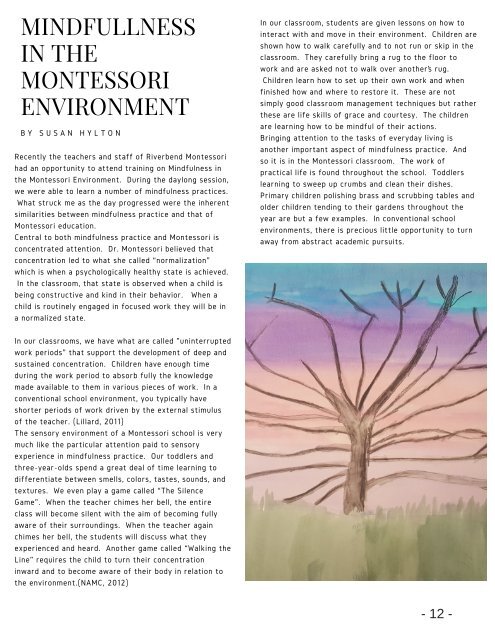Riverbend Montessori Spring 2018 Newsletter (3)
You also want an ePaper? Increase the reach of your titles
YUMPU automatically turns print PDFs into web optimized ePapers that Google loves.
MINDFULLNESS<br />
IN THE<br />
MONTESSORI<br />
ENVIRONMENT<br />
B Y S U S A N H Y L T O N<br />
Recently the teachers and staff of <strong>Riverbend</strong> <strong>Montessori</strong><br />
had an opportunity to attend training on Mindfulness in<br />
the <strong>Montessori</strong> Environment. During the daylong session,<br />
we were able to learn a number of mindfulness practices.<br />
What struck me as the day progressed were the inherent<br />
similarities between mindfulness practice and that of<br />
<strong>Montessori</strong> education.<br />
Central to both mindfulness practice and <strong>Montessori</strong> is<br />
concentrated attention. Dr. <strong>Montessori</strong> believed that<br />
concentration led to what she called “normalization”<br />
which is when a psychologically healthy state is achieved.<br />
In the classroom, that state is observed when a child is<br />
being constructive and kind in their behavior. When a<br />
child is routinely engaged in focused work they will be in<br />
a normalized state.<br />
In our classroom, students are given lessons on how to<br />
interact with and move in their environment. Children are<br />
shown how to walk carefully and to not run or skip in the<br />
classroom. They carefully bring a rug to the floor to<br />
work and are asked not to walk over another’s rug.<br />
Children learn how to set up their own work and when<br />
finished how and where to restore it. These are not<br />
simply good classroom management techniques but rather<br />
these are life skills of grace and courtesy. The children<br />
are learning how to be mindful of their actions.<br />
Bringing attention to the tasks of everyday living is<br />
another important aspect of mindfulness practice. And<br />
so it is in the <strong>Montessori</strong> classroom. The work of<br />
practical life is found throughout the school. Toddlers<br />
learning to sweep up crumbs and clean their dishes.<br />
Primary children polishing brass and scrubbing tables and<br />
older children tending to their gardens throughout the<br />
year are but a few examples. In conventional school<br />
environments, there is precious little opportunity to turn<br />
away from abstract academic pursuits.<br />
In our classrooms, we have what are called "uninterrupted<br />
work periods" that support the development of deep and<br />
sustained concentration. Children have enough time<br />
during the work period to absorb fully the knowledge<br />
made available to them in various pieces of work. In a<br />
conventional school environment, you typically have<br />
shorter periods of work driven by the external stimulus<br />
of the teacher. (Lillard, 2011)<br />
The sensory environment of a <strong>Montessori</strong> school is very<br />
much like the particular attention paid to sensory<br />
experience in mindfulness practice. Our toddlers and<br />
three-year-olds spend a great deal of time learning to<br />
differentiate between smells, colors, tastes, sounds, and<br />
textures. We even play a game called “The Silence<br />
Game”. When the teacher chimes her bell, the entire<br />
class will become silent with the aim of becoming fully<br />
aware of their surroundings. When the teacher again<br />
chimes her bell, the students will discuss what they<br />
experienced and heard. Another game called “Walking the<br />
Line” requires the child to turn their concentration<br />
inward and to become aware of their body in relation to<br />
the environment.(NAMC, 2012)<br />
- 12 -


